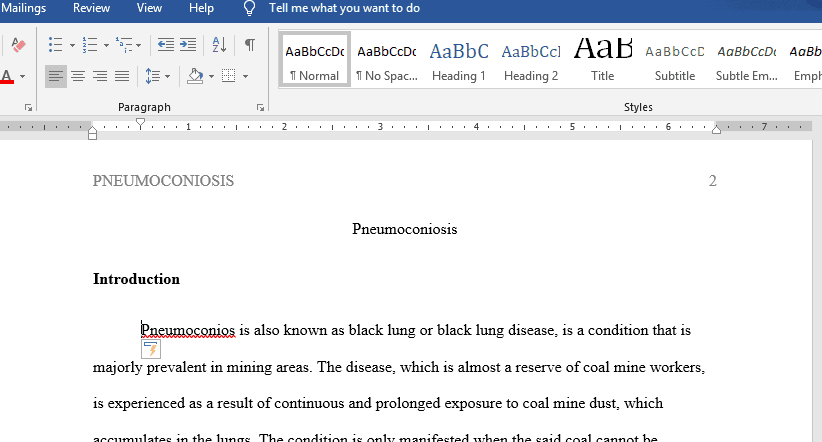Evaluate the presence and effects of alteration in the homeostatic state secondary to gender
Evaluate the presence and effects of alteration in the homeostatic state secondary to gender, genetic, ethnic and temporal variables. Select one of the case studies below, and include in your discussion an evaluation of the presence and effects of alteration in the homeostatic state secondary to gender, genetic, ethnic, and temporal variables.
Requirements:
Make sure all of the topics in the case study have been addressed.
Cite at least three sources; journal articles, textbooks or evidenced-based websites to support the content.
All sources must be within 5 years.
Do not use .com, Wikipedia, or up-to-date, etc., for your sources.
Case Study 1: Structure and Function of the Respiratory System
Brad is 45 years old and has been working as a coal cutter in a mine for the last 25 years. He likes the job because it pays well and the same mine had employed his father. Like many of his colleagues, Brad has had problems with a chronic cough. He has avoided his annual checkups for fear that he will be told he has “black lung,” or coal worker’s pneumoconiosis. The disease causes fibrosis, decreased diffusing capacity, and permanent small airway dilation. In later stages, pulmonary capillaries, alveoli, and airways are destroyed.
How can the disease described above create a mismatch between ventilation and perfusion? Use your understanding of alveolar dead space and physiologic shunt to explain your answer.
Individuals with chronic obstructive pulmonary disease have more difficulty exhaling than inhaling. Why is this so?
In general terms, what mechanisms in lung disease can affect diffusing capacity across alveolar membranes? Use the Fick law to explain your answer.
Case Study 2: Respiratory Tract Infections, Neoplasms, and Childhood Disorders
Patricia was called at work by a woman at the local daycare center. She told Patricia to come and pick up her son because he was not feeling well. Her son, three-and-a-half-year-old Marshall, had been feeling tired and achy when he woke up. While at daycare, his cheeks had become red and he was warm to touch. He did not want to play with his friends, and by the time Patricia arrived, he was crying. Later that afternoon, Marshall’s condition worsened. He had fever, chills, a sore throat, runny nose, and a dry hacking cough. Suspecting Marshall had influenza, Patricia wrapped him up and took him to the community health care clinic.
Why did Marshall’s presentation lead Patricia to think he had influenza and not a cold? Why is it important to medically evaluate and diagnose a potential influenza infection?
Describe the pathophysiology of the influenza virus. Outline the properties of influenza A antigens that allow them to exert their effects in the host.
Marshall may be at risk at contracting secondary bacterial pneumonia. Why is this so? Explain why cyanosis may be a feature associated with pneumonia.
Case Study 3: Disorders of Ventilation and Gas Exchange
Emmanuel and his mother live in an urban community housing complex. The building is worn down and dirty from the urban dust, cockroaches, and mold. Emmanuel is five years of age and has suffered from asthma for the last two years. One evening, his mother poured him some milk and put him to bed. Shortly afterward, Emmanuel woke up wheezing and coughing. As he gasped for air, he became more and more anxious. His mother ran for his inhaler, but he was too upset and restless to use it. Emmanuel’s skin became moist with sweat, and as he began to tire, his wheezing became quieter. His mother called 911 and waited anxiously for the ambulance to arrive.
Emmanuel uses a corticosteroid inhaler for the management of his asthma. What is the mechanism of action of this drug? How is its action different from the β2-agonist inhalants?
Why does someone with severe asthma become physically fatigued during a prolonged attack? What are the physiological events that occur during an attack?
One of the complications of respiratory fatigue is the development of hypercapnia. How does the body compensate for an increase in CO2? What are the effects of hypercapnia on the central nervous system?
Assignment Requirements:
- Before finalizing your work, you should:
- Ensure you have written at least four double-spaced pages.
- be sure to read the Assignment description carefully (as displayed above);
- consult the Grading Rubric (under the Course Resources) to make sure you have included everything necessary; and
- utilize spelling and grammar check to minimize errors.
- follow the conventions of Standard American English (correct grammar, punctuation, etc.);
- be well ordered, logical, and unified, as well as original and insightful;
- display superior content, organization, style, and mechanics; and
- use APA 6th Edition format.
Answer Preview to Community Health Center Efficiency
APA
1102 words



